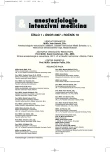-
Medical journals
- Career
Early urine and blood biochemical changes in experimental model of sepsis
Authors: M. Fencl 1; M. Matějovič 2; A. Kroužecký 2; L. Dadák 1; I. Novák 2; V. Šrámek 1
Authors‘ workplace: Anesteziologicko-resuscitační klinika Fakultní nemocnice u svaté Anny v Brně 1; JIP I. interní klinika Fakultní nemocnice Plzeň 2
Published in: Anest. intenziv. Med., 18, 2007, č. 1, s. 40-44
Category: Intensive Care Medicine - Original Paper
Overview
Objective:
To compare biochemical changes in the blood and urine in the early phase of an experimental model of sepsis.Design:
Experimental, prospective trial.Setting:
ICU of the 1st Medical Department, Charles University, Medical School and Teaching Hospital Plzen, Czech Republic. Department of Anaesthesia and Intensive Care, St. Ann’s University Hospital Brno, Czech Republic.Materials and methods:
Twelve pigs weighing 24 kg (18; 30) were studied for 12 hrs after the induction of experimental G-negative volume-resuscitated sepsis.The sepsis was induced with a continuous live Pseudomonas aeruginosa i.v. infusion. Within the scope of the original protocol aimed at researching the role of NO and oxidative stress on the splanchnic perfusion and metabolism, the haemodynamic parameters and diuresis were monitored in hourly intervals. At time points T₀, T₂,T₆ and T1₁₂ a biochemical analysis of the blood and urine was performed.The blood analysis comprised the acid-base status, blood gases, electrolytes, lactate and creatinine. The urine analysis included the pH, sodium, potassium, creatinine and osmolality measurements.Results:
Development of metabolic acidosis (present at T₂) lead to a significant drop in the urinary pH from 6.2 (5.0;8.0) to 5.5 (5.0;7.2). Sepsis caused sodium and potasssium retention, the sodium/potassium ratio changed randomly. Osmolality of the urine decreased significantly from 664 (489;811) mmol . kg⁻¹ to 338 (167;625) mmol . kg⁻¹.Conclusion:
Experimental G-negative sepsis lead to a decrease in the blood pH followed by a decrease in the urinary pH within a few hours. The clinical relevance of these early changes warrants further evaluation.Keywords:
sepsis – metabolic acidosis – urinary pH
Labels
Anaesthesiology, Resuscitation and Inten Intensive Care Medicine
Article was published inAnaesthesiology and Intensive Care Medicine

2007 Issue 1-
All articles in this issue
- The American Society of Anesthesiologists’ (ASA) Classification of Physical Status – time for change?
- Automatic control of rocuronium-induced neuromuscular block during long-lasting neurosurgical interventions
- Incidence of postoperative residual curarization following cisatracurium and rocuronium-induced neuromuscular block: a prospective study
- Intramuscular suxamethonium in experiment and in clinical practice
- Early urine and blood biochemical changes in experimental model of sepsis
- Lev Spinadel – founder of anaesthesiology in Czechoslovakia
- Anaesthesiology and Intensive Care Medicine
- Journal archive
- Current issue
- Online only
- About the journal
Most read in this issue- The American Society of Anesthesiologists’ (ASA) Classification of Physical Status – time for change?
- Lev Spinadel – founder of anaesthesiology in Czechoslovakia
- Incidence of postoperative residual curarization following cisatracurium and rocuronium-induced neuromuscular block: a prospective study
- Early urine and blood biochemical changes in experimental model of sepsis
Login#ADS_BOTTOM_SCRIPTS#Forgotten passwordEnter the email address that you registered with. We will send you instructions on how to set a new password.
- Career

